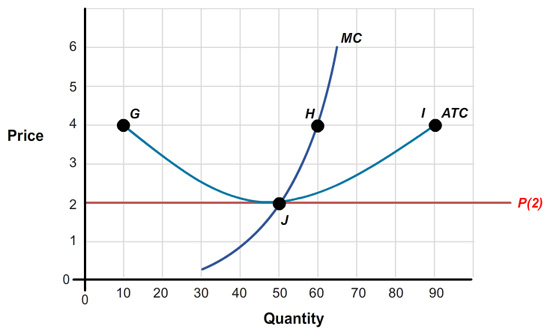Chapter 1. Chapter 8
Step 1
Question
Consider the following graph: The graph represents a competitive firm. The marginal cost (MC) curve, average total cost (ATC) curve, and price (P) line corresponding to each level of output (Q) are given in the graph.

A competitive firm maximizes profits if P equals U26uvk3JWocGK6yagR1dsA==.
Step 2
Question

If P = $4, point P6RcF6ZuUiMAH6k+l8Ub8cwBdgTHPQv7FN0uGlPtmPLHW3nGsOZI3FyOzvymvszx determines the profit-maximizing quantity.
Step 3
Question

If P = $4, the profit-maximizing quantity in this graph is SeGVZpRlQr2NC0nVWJqkbA== units.
Step 4
Question

If P = $4 and Q = 60 units, how much is this firm’s revenue? Answer using a whole number. $krOSu23SrvtefqEkW5ws5Diw40xZY8p1BKePxg==
Step 5
Question

In this graph, ATC at Q = 60 units is closest to buItxLvf0WvRi2caMqvtq33VrD+XobIX.
Step 6
Question

If Q = 60 units and ATC = $2.25, how much is this firm’s total cost (TC)? Answer using a whole number. $S1y7VnbpjG4QH9k2x8UA2VEMCzfSMVjzkpsYGQ==
Step 7
Question

If Q = 60 units and ATC = $2.25, how much is this firm’s profit? Answer using a whole number. $mah7dl7hyKoezSDEL8vgoA==
Step 8
Question

In the long run, a competitive firm maximizes profits if P equals MC, equals jSgAWvYu6Rtj7Bpxsh/3WyKsdW3Q/FEY32QcfBWqgrdnbDBlYL8Dfbehuhzz0zAKgfmL4g==.
Step 9
Question

In this graph, minimum ATC occurs when P = P02YILpI5fyoFfPUbdYHRg==.
Step 10
Question

If P = $2, the profit-maximizing quantity in this graph is CT5odGJ3Ovb4S4XX/d4OVA== units.
Step 11
Question

If P = $2 and Q = 50, how much is this firm’s revenue? Answer using a whole number. $MDilpcxJNnDF0tME3CNNvAOpOetQk+mKrbCLtw==
Step 12
Question

If Q = 50 units and ATC = $2.00, how much is this firm’s total cost (TC)? Answer using a whole number. $HvJ6RDZ5HfzsGIhv2SbOYg==
Step 13
Question

If Q = 50 units and ATC = $2.00, how much is this firm’s profit? Answer as a whole number. $1Wh3cvJ2xF4=